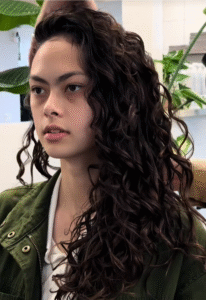For most of her life, Mia thought her curls were something to hide. Growing up, she envied the girls with sleek, straight hair that always fell perfectly into place. Her mornings were spent with a flat iron in one hand and frustration in the other, trying to force her wild spirals into submission. Every hiss of steam, every whiff of burnt ends, felt like victory—but it came at a price.
Years of straightening left her hair dry, brittle, and lifeless. The curls that once framed her face so naturally became thin and fragile. Every time she looked in the mirror, she saw more damage and less of herself. “I thought I had to change to be pretty,” she admitted later. “But I was just burning away the best part of me.” It wasn’t until college that everything shifted. One rainy morning, as Mia rushed to class, she forgot her umbrella and got caught in a downpour. By the time she made it inside, her carefully straightened hair had transformed into a frizzy halo of curls. She wanted to cry—until a classmate smiled and said, “Your hair looks amazing like that. You should wear it natural more often.”
That single comment planted a seed. For the first time, she wondered what it would be like to stop fighting her hair and start understanding it instead. The next day, she put her straightener away. It wasn’t easy at first. The transition period—when hair is half-damaged and half-healing—was awkward. Her curls felt unpredictable, her confidence unsteady. But week by week, things began to change.
She learned the importance of hydration, switching from harsh shampoos to gentle, sulfate-free cleansers. Deep-conditioning masks became her weekend ritual, and leave-in creams replaced heat tools. She started using a microfiber towel instead of rubbing her hair dry and learned the “scrunch” technique to encourage her natural curl pattern. Every small step brought a little more definition, a little more bounce, a little more her.
Three months in, she began to see the difference. The frizz softened, the curls shaped themselves, and her hair regained its shine. Friends began to notice too. “You look different,” they’d say, but not because of the hair alone. There was something brighter in her eyes, something lighter in her smile. She no longer walked with her hand over her head on humid days—she walked with pride. Now, years later, Mia’s hair is a full crown of soft spirals that move freely in the wind. She laughs at how much time she used to spend trying to change what made her unique. “It’s funny,” she says. “I thought straight hair would make me beautiful. But I didn’t feel beautiful until I saw my curls again.”
Her transformation wasn’t just physical—it was emotional. Each curl became a reminder of resilience, each coil a symbol of authenticity. Caring for her hair taught her patience, but embracing it taught her self-love. She learned that true beauty doesn’t come from forcing yourself into a mold—it comes from embracing what was always yours. Now, when people ask for her secret, Mia smiles. “The secret is letting go,” she says. “Once you stop trying to fix yourself, you realize there was never anything wrong with you in the first place.” Her story is one shared by countless others who’ve learned that curls aren’t meant to be tamed—they’re meant to be celebrated. Because every curl has a story, and sometimes, all it takes is a little courage to let it shine.


